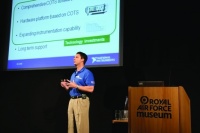There was a lot of very old hardware and hardly any electronics or software in sight at the location that National Instruments chose to hold its Aerospace and Defence Forum this month.
But that was not unexpected, since the event took place at the Royal Air Force museum in London which houses a vast collection of old, unusual, beautiful - as well as some rather ugly - aircraft from the last century.
Fortunately for those engineers that attended the event expecting to see some high-technology equipment, there was plenty of it on display at the National Instruments forum itself, providing an unsettling disparity to the equipment used to build many of the aircraft housed in the historic hangers of the museum.
Despite the contrast between the technology used in the old aircraft and the microprocessor-based software-driven solutions from National Instruments, the exhibits acted as a stark reminder that designers of products for the aerospace field must always be cognisant of the fact that their equipment may have a lifecycle of many decades, rather than just a few years.
That point wasn’t lost on Sean Thompson, National Instruments’ Austin-based platform manager for aerospace and defence applications, who addressed the unique issues of developing both test systems and embedded systems with long lifecycles at his keynote speech at the forum.
Every system goes through a series of stages from the time that it is first conceived to when it is deployed in the field. From the day that its function is first defined, through design and development, production and deployment to operation and support, manufacturers must be aware that they may need to maintain the equipment over several decades.
Importantly, both the hardware and software used to build today’s aerospace systems have their own lifecycles. And the challenge faced by manufacturers is how to deal with all of the different lifecycles of such products to effectively manage the obsolescence of the hardware and software through the lifetime of their products.
According to National Instruments Thompson, although hardware is the most common cause of obsolescence in military and aerospace systems, in reality, most studies have shown that the majority of cost is incurred at the software level when designers are reacting to those changes in hardware.
Fortunately, for designers of such systems, one strategy that they can put in place to mitigate the effects of obsolescence is to design and develop systems based on modular hardware and software architectures.

On the hardware front, design engineers can take advantage of COTS electronics packaged into modules that can be deployed either to build instrumentation systems or in embedded systems. In doing so, however, Thompson said that developers should work closely with hardware suppliers such as National Instruments to identify which key hardware components may need to be supported over long periods of time, so that they can negotiate long term support contracts to mitigate risk.
Along similar lines, designers should also choose the hardware in such systems to perform just the fundamental functions that are required. Although some speciality hardware may always be needed, bringing most of the specialty functions of the system - especially analogue functions - into the software application will allow designers to exert more control over the design and minimise the risk of obsolescence.
Thompson said that another way designers can protect themselves against hardware obsolescence is to ensure that the system they design is built using stratified software layers that effectively isolate the hardware from the application. In that way, as the hardware offerings from suppliers change and functionality increases, the software interfaces through which the designer uses to control it remains stable.
No National Instruments event would be complete without some mention of the company’s graphical design software LabVIEW. Here too, Thompson was keen to point out its advantages to developers of aerospace equipment.
From an obsolescence perspective, he cited the fact that developing software in such a fashion not only enables designers to migrate code to different hosts over time if need be, but also to deploy code on FPGAs on instrumentation cards, enabling many previous analogue hardware functions to be replaced by software.
In his closing remarks to the conference, Thompson warned that no matter how well a company does develop a system to mitigate the effects of obsolescence, they should still put into place a reactive strategy that will enable them to find alternative sources of parts, to make lifetime buys, or in extreme cases, redesign the system completely.




Red Bull makes hydrogen fuel cell play with AVL
Formula 1 is an anachronistic anomaly where its only cutting edge is in engine development. The rules prohibit any real innovation and there would be...